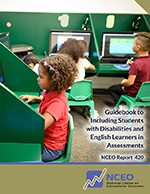The Guidebook to Including Students with Disabilities and English Learners in Assessments (NCEO Report 420) provides 10 lessons about how to ensure inclusive assessment practices for students with disabilities, English learners, and English learners with disabilities. It is directed to state department of education staff and others interested in ensuring that assessments and assessment policies are inclusive of all students in the most appropriate ways possible.
The 10 lessons highlighted in the Guidebook are:
- Lesson 1. Know the student populations in your state and their characteristics.
- Lesson 2. Develop a basic understanding of how the principles of universal design apply to assessments.
- Lesson 3. Examine laws, professional standards, principles, and policies on including students with disabilities and English learners in assessments.
- Lesson 4. Gain an understanding of why it is important to include all students in assessment systems, including students with disabilities, English learners, and English learners with disabilities.
- Lesson 5. Review the many lessons learned about accessible assessments.
- Lesson 6. Work with stakeholders to develop guidance for the field on making important testing decisions.
- Lesson 7. Think through intended uses of assessment results and approaches to reporting results that meet federal and professional requirements and also serve the needs of stakeholders who receive reports.
- Lesson 8. Realize that ensuring full implementation is partly the state’s responsibility.
- Lesson 9. Focus on continuous improvement of the assessment system.
- Lesson 10. Learn from peers, including individuals in other states, as well as from national organizations and technical assistance partners.

